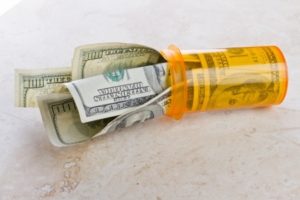Between 2015 and 2017, 25% of all U.S. hospitals cut staff to cope with budget shortfalls caused by rapidly rising drug costs, reports a recent study. Hospital drug spending increased 18.5% during those two years.
 The Key Findings About Rising Hospital Drug Costs
The Key Findings About Rising Hospital Drug Costs
The study, prepared by the research group NORC at the University of Chicago, was commissioned by the American Hospital Association, the Federation of American Hospitals and the American Society of Health System Pharmacists. NORC based its analysis on a variety of data from more than 4,200 U.S. hospitals and two group purchasing organizations and conducted informational interviews with hospital executives.
The report produced seven key findings into the impact of drug costs on hospital staffing levels. According to Becker’s Hospital Review:
- U.S. community hospitals spent an average of $555.40 on prescription medications for each admitted patient in 2017, versus $468.50 per patient in 2015. The increase per admitted patient meant an $1.8 million jump in new spending for the average U.S. hospital.
- The 18.5% growth in total drug spending far outpaces inflation. Inflation was 6.4% during the same time period.
- Outpatient drug spending per patient admission increased 28.7%, and inpatient spending grew 9.6% from 2015 to 2017.
- U.S. hospitals spent more than $210 million on Activase, a widely used medicine used to treat heart attack and stroke patients. The unit price of Activase increased by 18.8% to $4,143 in 2017, up from a unit price of $3,486 in 2015. Several other commonly used drugs cited in the report that increased significantly, include Remicade, Humira and Enbrel. All went up between 15% and 21% during 2015 to 2017.
- The main drivers of the increases were high list prices set by pharmaceutical companies and shortages of critical medications, such as saline and generic injectables.
- Roughly 80% of hospitals found it extremely difficult to obtain drugs in short supply.
- To reduce the budget pressures brought on by increasing drug prices, 90.3% of hospitals used alternative therapies, while 25% reduced staff.
Other sobering findings included:
- Hospitals saw price increases of more than 80% for anesthetics, parenteral solutions, opioid agonists and chemotherapy.
- Payers were unable to keep up with rising drug costs, e.g., the growth in expenditures per hospital admission on inpatient drugs exceeded the Medicare reimbursement update five-fold during the study period.
- Hospitals reported that drug shortages put patient care at risk and created additional burden and cost.
Read the full report, Recent Trends in Hospital Drug Spending and Manufacturer Shortages, here.







